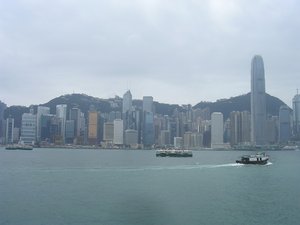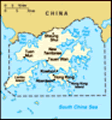Advertisement
Published: March 26th 2010

 Skyline in daylight
Skyline in daylight
Hong Kong's skyline is magnificent by day.Another day, another poor night’s sleep. I’m now having dreams about waking up early, followed by actually waking up. Maybe it’s
the Agency. I tried to go back to sleep but it wasn’t good.
Today I would spend the bulk of my day in Kowloon, across the bay from Hong Kong Island. I took the ferry across very rocky waters (I can’t believe no one is leaning over the side of the boat on these) and was treated to the beautiful skyline in daylight.
My first stop was the Avenue of Stars which is a sort of Hollywood Walk of Fame for Chinese stars (it also provides spectacular views of the skyline). I hadn’t heard of most of the stars until I reached Bruce Lee’s and Jackie Chan’s stars, which were side by side. I also saw Jet Li’s, which shows they are clearly stretching it. That guy is like the antithesis of Tom Hanks: you go to see a movie with Tom Hanks and it will most certainly be good; with Jet Li it will most certainly be abysmal.
After some walking around I stopped for lunch on Lock Road at a place called 98°C. There I tried

 Avenue of Stars
Avenue of Stars
Jackie Chan's star.Sichuan chicken and rice, requesting that the chicken be spicy. It came out a few minutes later, and upon my first taste I proclaimed that this was the best food I’ve had in weeks. The flavor was overwhelming. Tastes two and three brought about a bit of acidity and the spice just started to clear my sinuses. A couple bites later and things changed. I began to notice that this thing was loaded with salt; disgustingly so. I only ended up making it about halfway through the dish. My blood pressure may never be low again.
Following lunch, I tried to sweat out some of the salt with a long walk up Nathan Road and into the New Territories. I only went about a block in and really didn’t notice any difference in the areas, though I can’t say exactly what I expected. The big difference was the farther north I went, I gradually saw less and less tourists.
After heading back down from the New Territories through a couple street markets, I made my way to the Hong Kong Museum of History. Inside, I learned about Hong Kong’s history, focusing more on its geologic formation and that

 Lunch
Lunch
It started out great but grew worse and worse.since its interactions as a trade port with European countries, especially Britain and Portugal, with only a brief pass through the areas on prehistory, the dynasties and folk culture.
Hong Kong as it is today, like many parts of the Pacific Rim, was formed through the rise of volcanic mountains from plate tectonics. Following the ice age, rising seas buried most of the land mass beneath the water, leaving a series of more than 200 islands, the largest of which is Hong Kong Island.
In the early 16th century, after the discovery of sea trade routes, Hong Kong developed into a trade port between China and the west. In the early to mid 19th century, China, through the Qing Dynasty, refused to allow Britain to import opium from Goa (India) leading to the Opium Wars. Hong Kong Island became occupied by British forces and was eventually ceded to Britain. A second war arose, leading to the cessation of the Kowloon Peninsula and Stonecutter’s Island and, just before the turn of the century, Lantau Island in the New Territories on a 99 year lease.
Hong Kong remained a British sea port for the bulk of the next century.

 Kowloon
Kowloon
One of the streets in Kowloon.With British influence, it grew into a pseudo western city, complete with grocery stores, post offices, tea stores, banks, trade shops, shipping, pawn shops and schools. The museum had replicas of each of these on display.
During WWII, Hong Kong suffered an air raid on December 8, 1941, just hours after the attack on Pearl Harbor. Within days Japan occupied the city, embarking on its plan for the
Japanization of Hong Kong, where it would implement Japanese style education, language and culture.
After Japan’s defeat, Hong Kong returned to being part of Britain. Over the coming decades, it continued to rebuild, with several hiccups along the way from severe storms and floods.
In the early 1980s, Britain and China began to discuss the issue of Hong Kong sovereignty, with the lease of the New Territories set to expire in less than 20 years. In 1984, Britain signed an agreement with the People’s Republic of China to transfer sovereignty to the PRC in 1997, having been completed on July 1, 1997.
Since then, Hong Kong has been governed under a system known as “one country, two systems”. Under this, Hong Kong has a high degree of autonomy,

 Ancient China
Ancient China
While Hong Kong stands out as a world center today, it was once very much embedded with Chinese culture.except in defense and foreign affairs. Mainland China remains socialist while Hong Kong is very much a capitalistic society and will continue to be until at least 2047, as stipulated in the Sino-British Declaration. After then, it is unknown what Hong Kong’s fate will be.
I had a really interesting day at the museum, receiving a very good overview on Hong Kong’s history. I especially liked learning about the Opium Wars and the “one country, two systems” policy as I found it a bit baffling when I was looking to visit here. For instance, Hong Kong has its own currency and I would need to get an actual Chinese visa to visit mainland China. Instead, I do not need a visa for up to 90 days in Hong Kong.
This evening I went to Temple Night Market in the very early evening when they were just setting up. I got a taste of it, realizing it is much like most other street markets I’ve been to. Afterwards I grabbed dinner nearby, having a Sonderbergh beer and pork chops in a BBQ sauce. The meal was far superior to my lunch.
With some time to spare between dinner

 Bank
Bank
A replica of the inside of a bank at the turn of the century.and my last activity of the evening, I decided to grab a beer. I had come across a German bar earlier today near the Avenue of Stars and immediately salivated at the thought of a delicious dark German beer. I stopped in and treated myself to an Erdinger Dunkel. How I’ve missed German beers.
The last event of the evening was certainly a grand finale. Back at the Avenue of Stars, overlooking the harbor, I watched the
Symphony of Lights. The Symphony of Lights is a sort of performance at 8:00 each night where 44 buildings along the Hong Kong skyline are interactively lit up with music playing in the background.
The show began by what appeared to be each building
bowing to the crowd with different light patterns flashing on each building as the names were individually announced. It continued for 15 minutes with various color patterns shining and lasers circling the sky. The show is a must see and certainly was a hit, making the already gorgeous skyline come alive.
After the show I made my way back to the hostel and tried to get to bed early. After a long day, I am beat.
Advertisement
Tot: 0.097s; Tpl: 0.019s; cc: 7; qc: 23; dbt: 0.0392s; 1; m:domysql w:travelblog (10.17.0.13); sld: 1;
; mem: 1.1mb











Wendy
non-member comment
That's crazy. The elementary school that I went to in Hong Kong had those same exact desks!